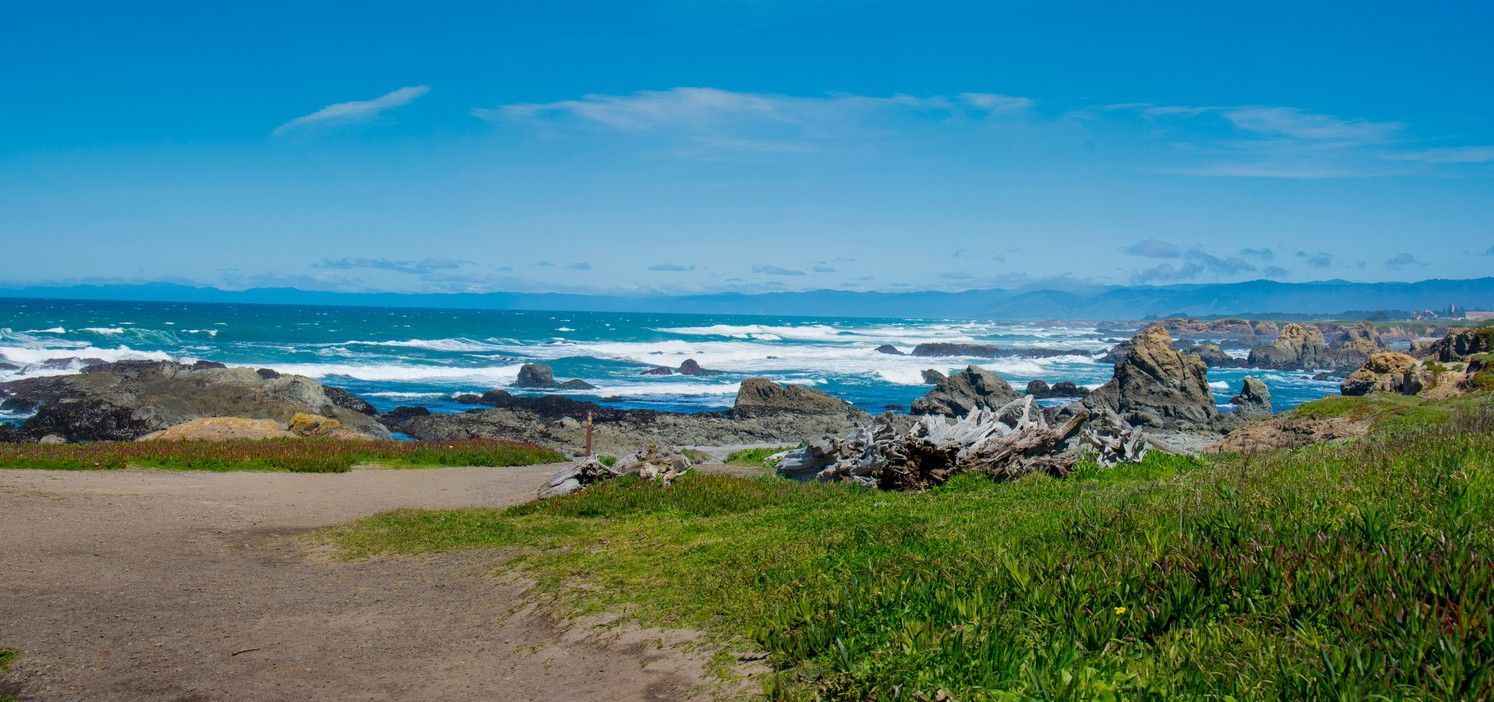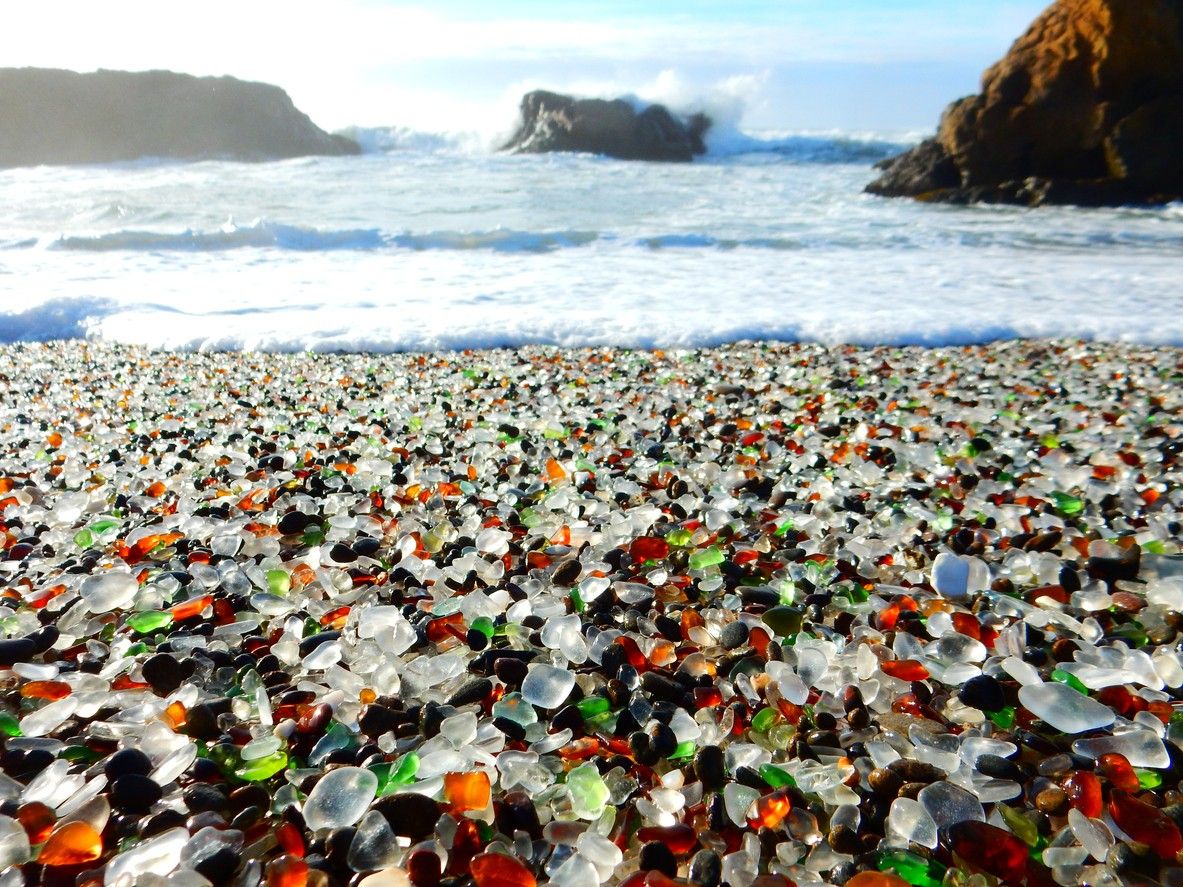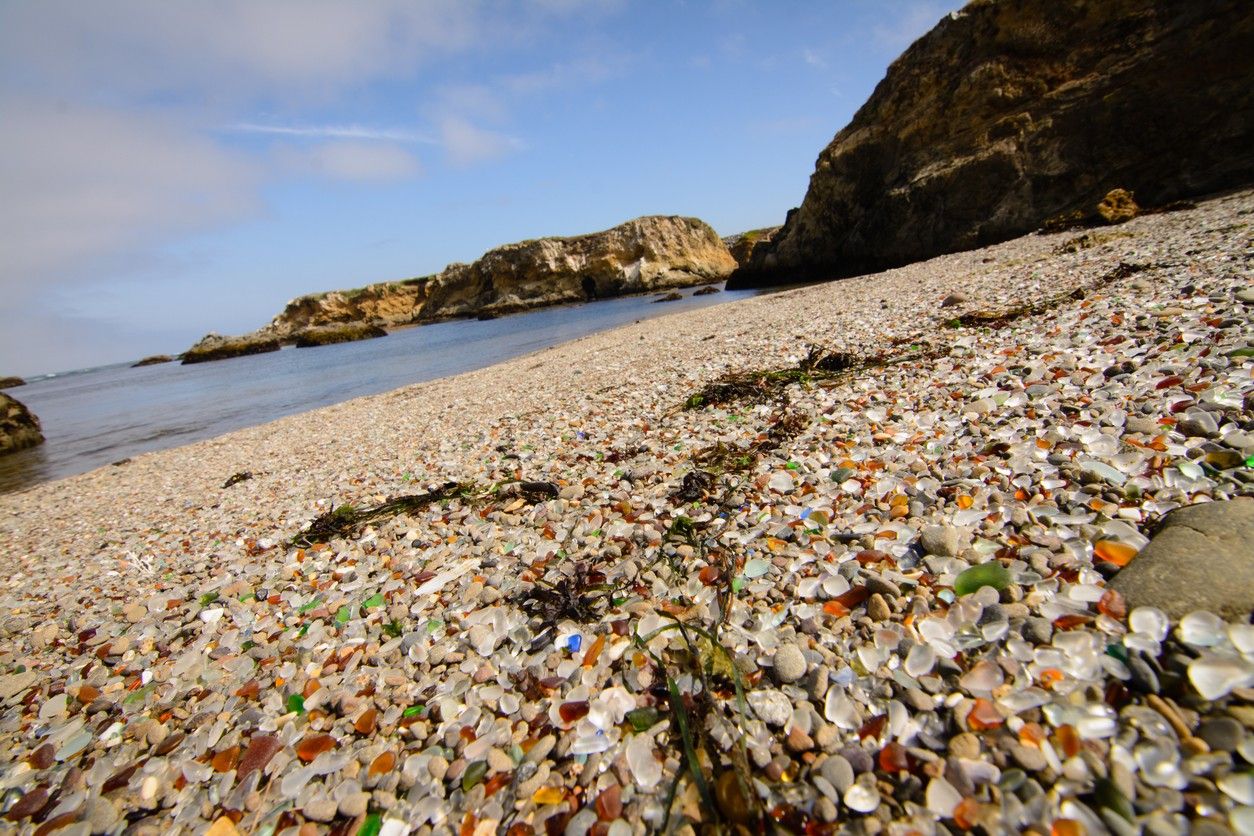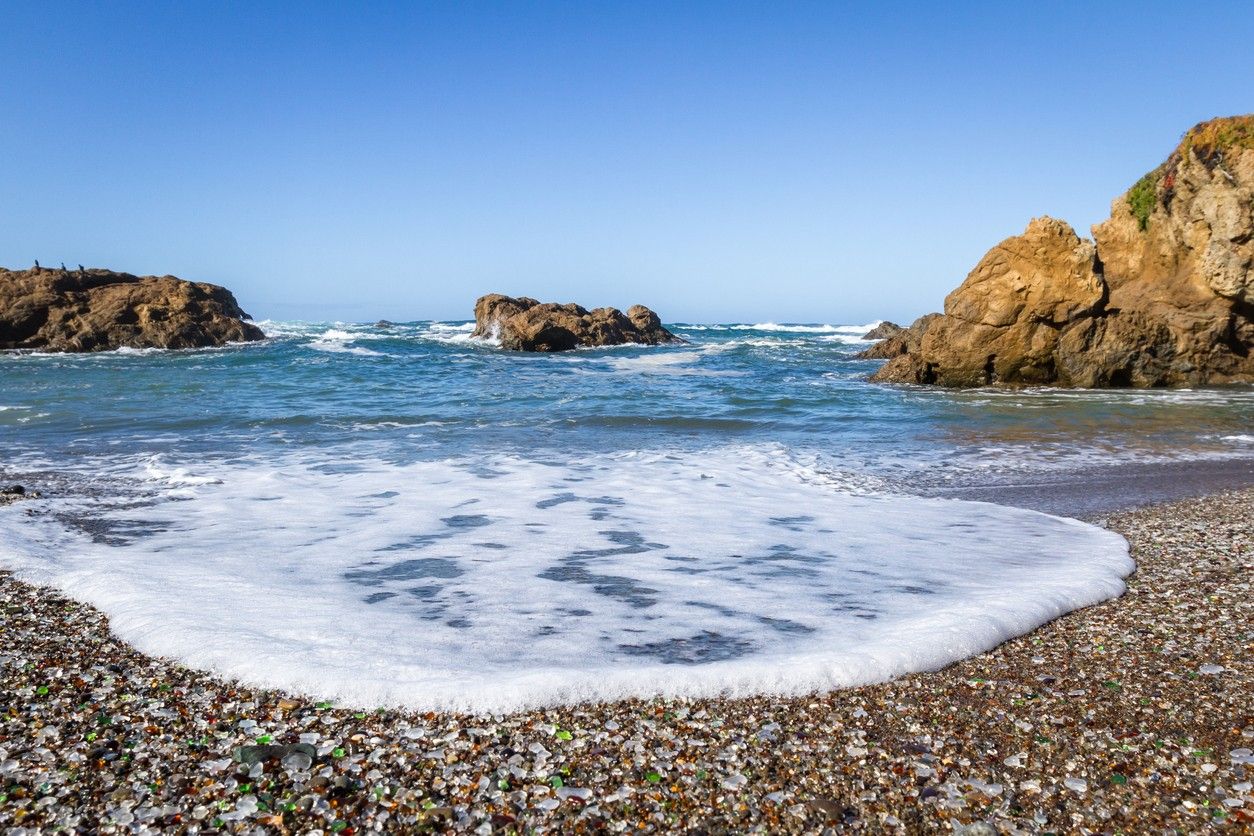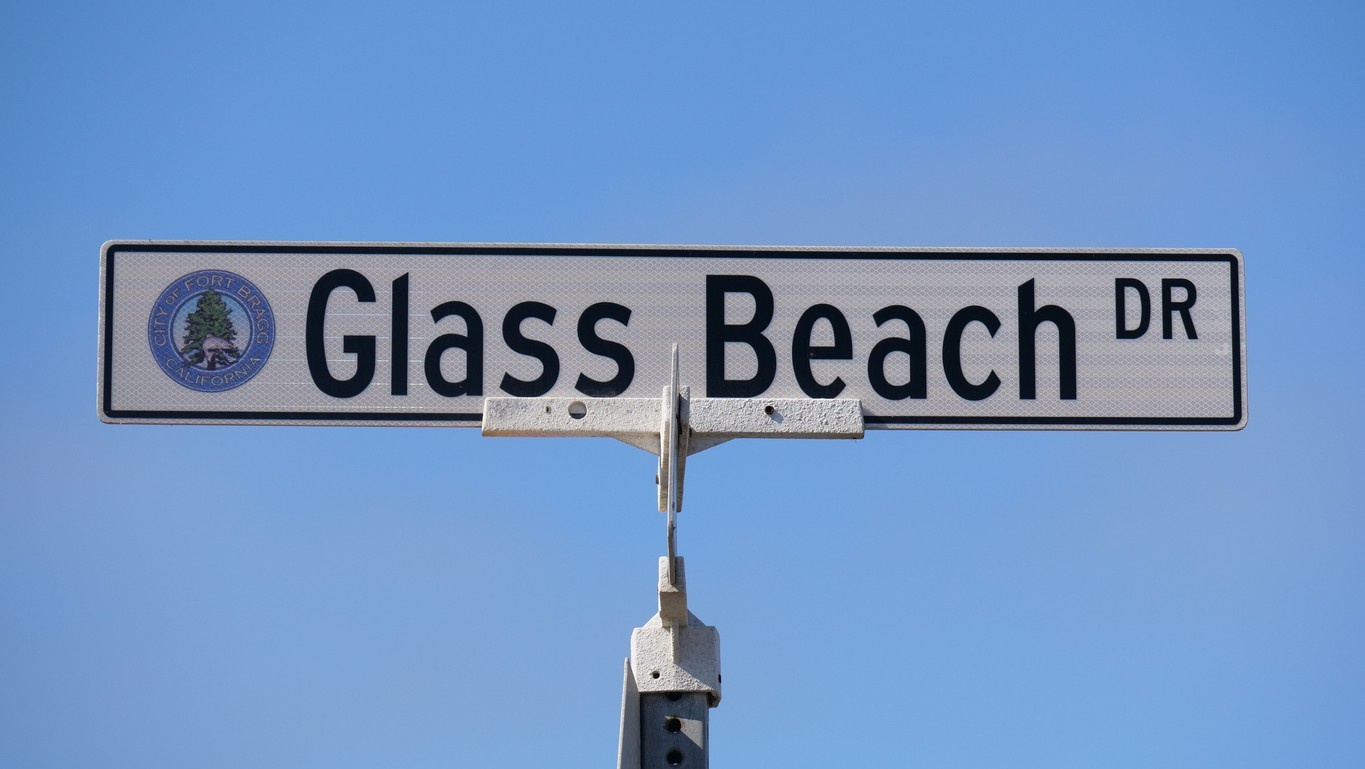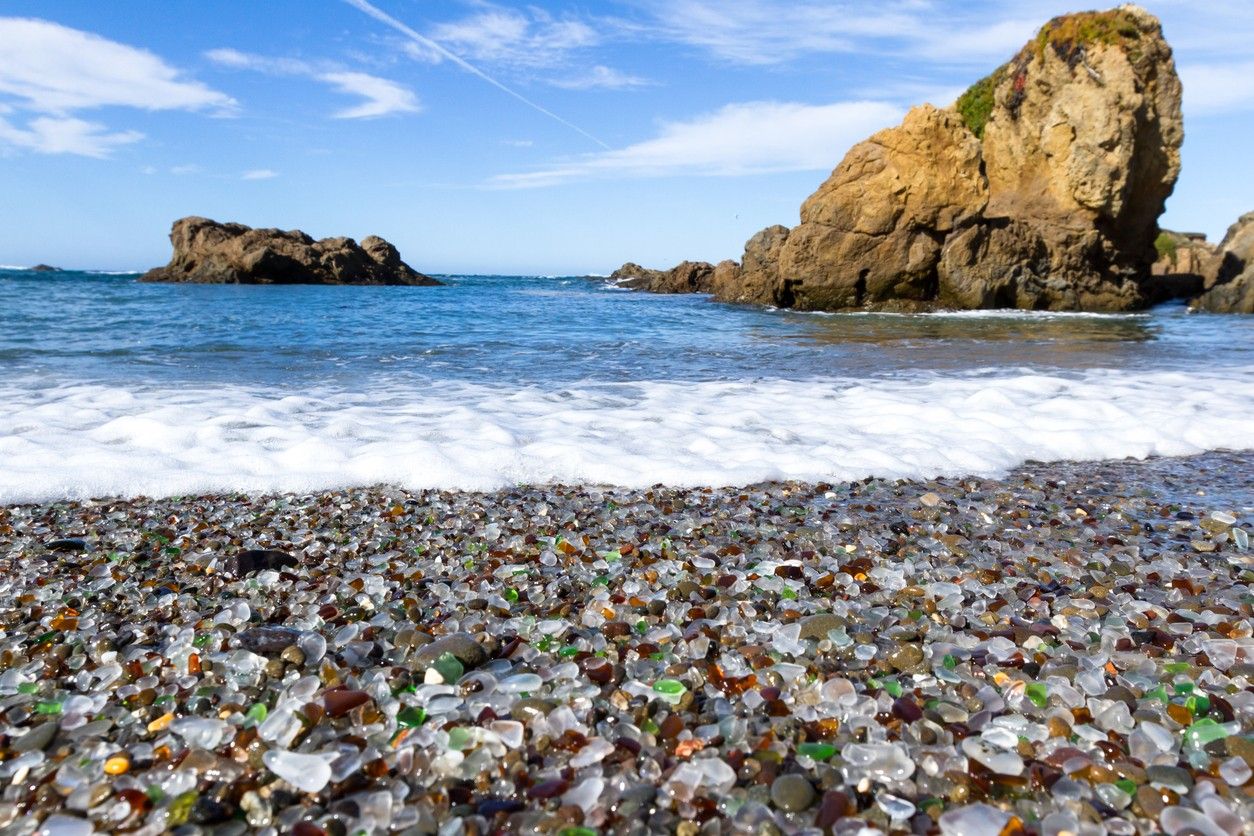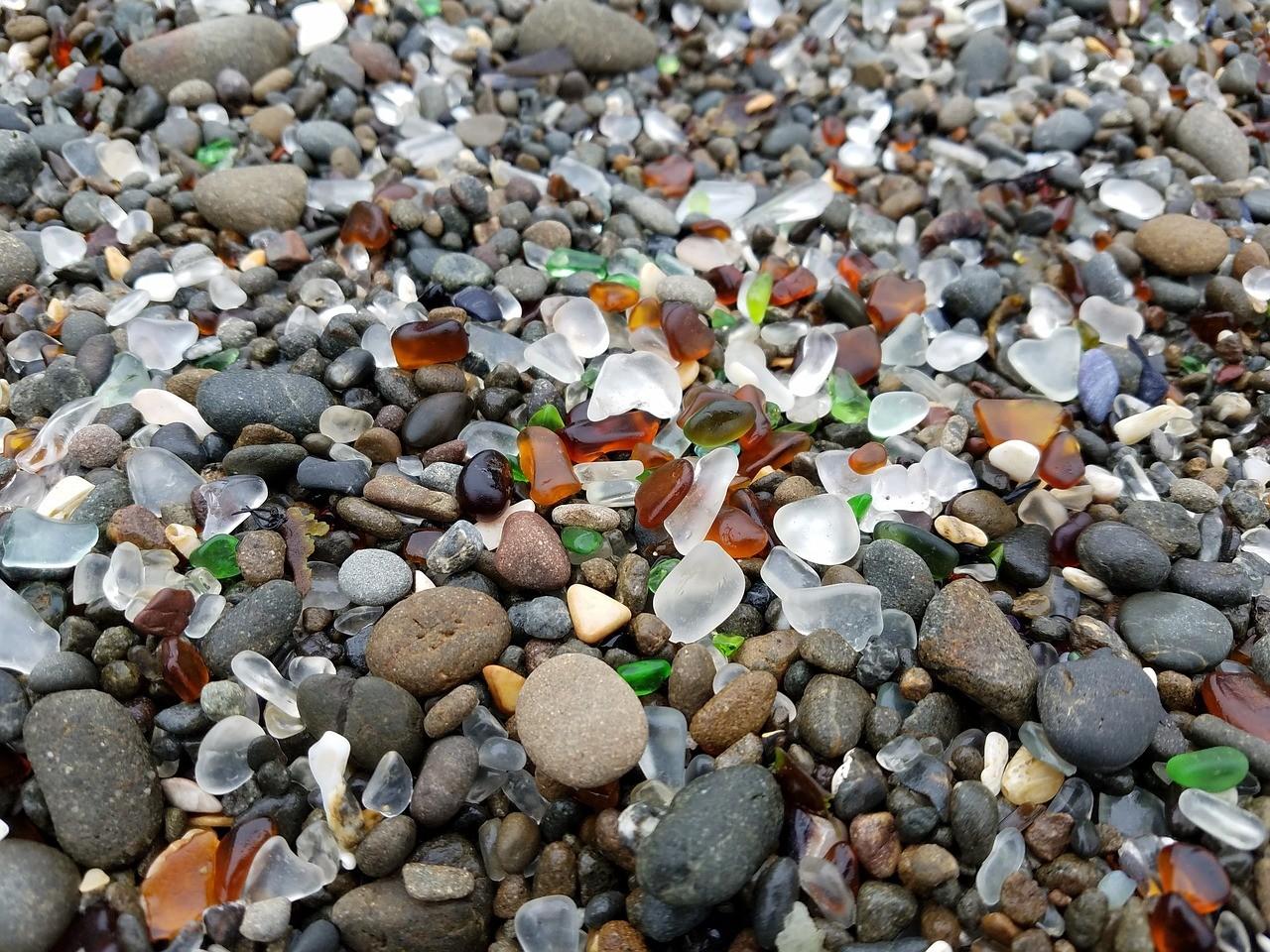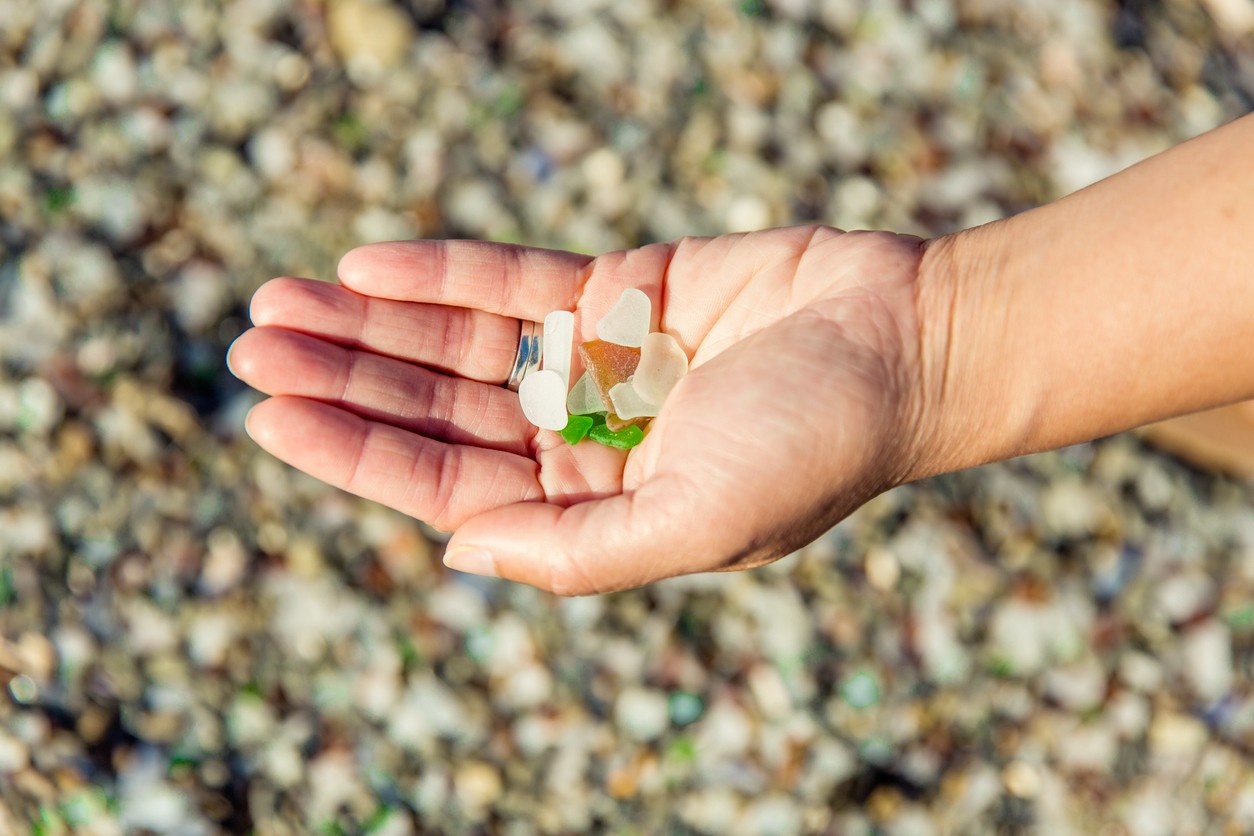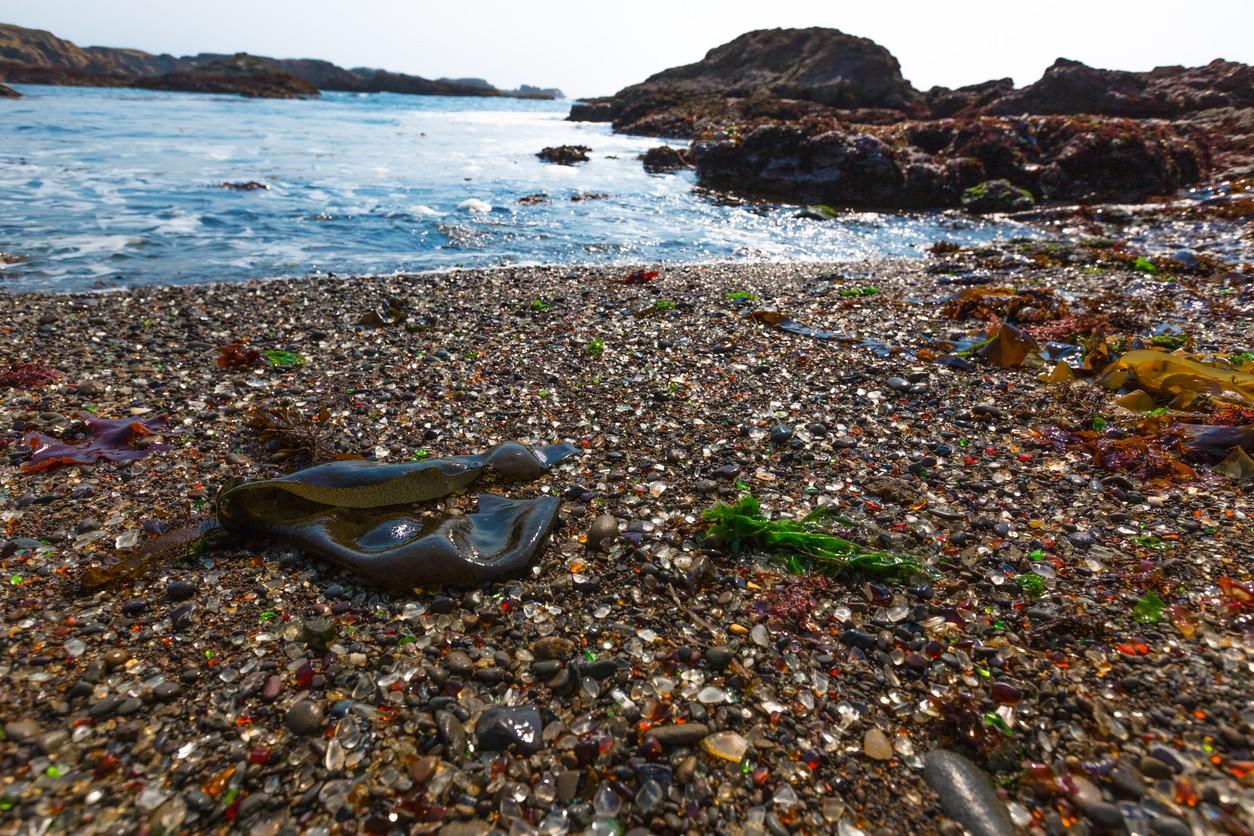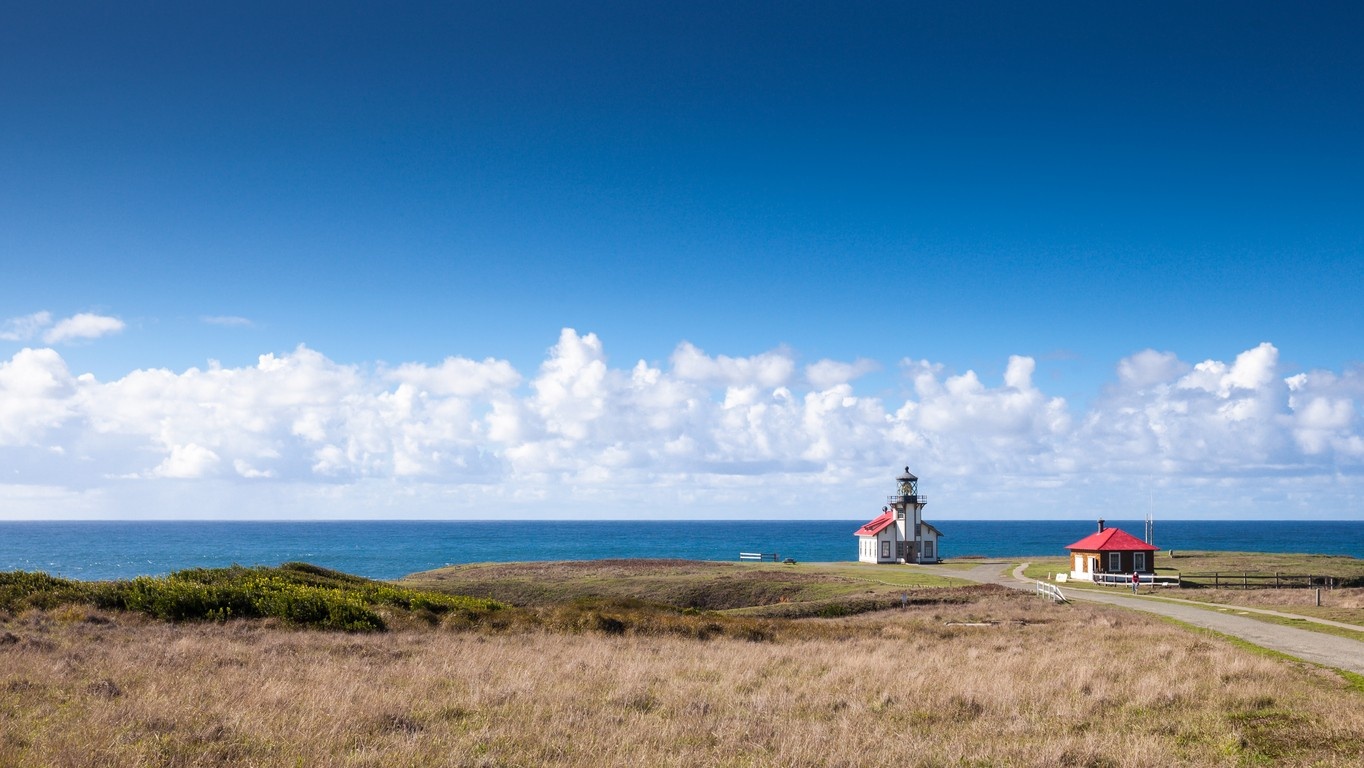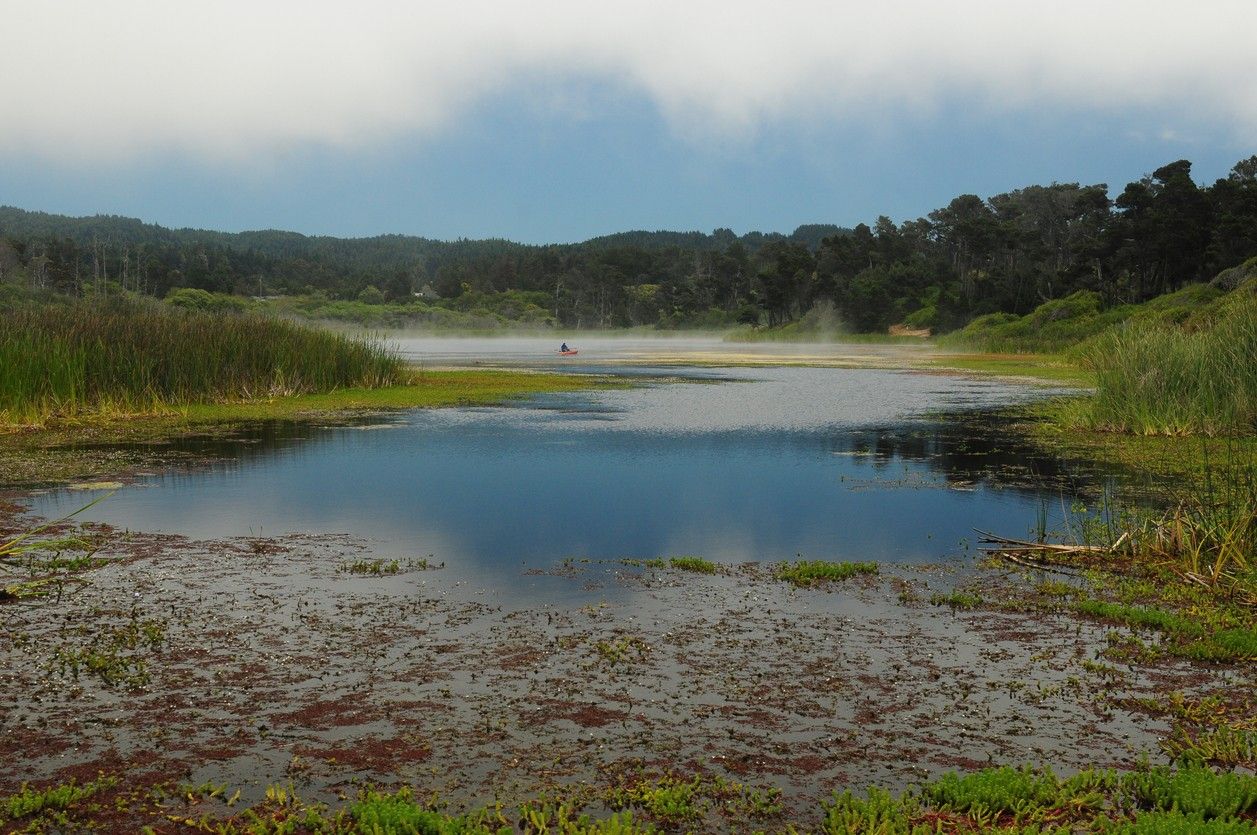Tucked away along the rugged Mendocino Coast of Northern California lies a natural wonder unlike any other. Glass Beach, a captivating destination born from an unlikely combination of human negligence and nature's incredible artistry, beckons visitors to experience a kaleidoscope of colours adorning its shimmering shores. What was once an accumulation of discarded bottles, ceramics, and household debris has been transformed over decades by the relentless power of the ocean's waves and currents. Through a remarkable process of erosion and polishing, these cast-off remnants have evolved into millions of smooth, translucent gems that now blanket the beach, dazzling the eye with their vibrant hues and velvety textures. From brilliant blues and fiery reds to warm ambers and soft pastels, the vibrant glass pebbles that adorn Glass Beach's coves create a visual feast that shifts and dances with the changing light. Each piece is a testament to nature's resilience and ability to reclaim and repurpose even the most unlikely materials, turning a blight into a breathtaking spectacle. More than just a visually stunning attraction, Glass Beach serves as a living laboratory, showcasing the intricate geological processes that shape our planet. The forces that sculpted these polished gems offer a glimpse into the dynamics of erosion, sedimentary processes, and the rock cycle on a compressed timescale, inviting visitors to marvel at the power and creativity of the natural world.
Yet, amidst its captivating beauty lies a poignant reminder of human activities' lasting impact on the environment. Glass Beach's existence serves as a cautionary tale, highlighting the importance of responsible waste management and sustainable practices to protect our fragile ecosystems. Explore the rugged cliffs, secluded coves, and shimmering shores of this remarkable coastal gem. Discover the history that shaped its formation, the conservation efforts that safeguard its future, and the unique geological wonders that make Glass Beach a true marvel of nature's artistry. Let this kaleidoscopic wonder inspire a deeper appreciation for the incredible transformative power of our planet and the vital role we all play in preserving its beauty for generations to come.
Glass Beach at a Glance:
Dog-friendly — Dogs are allowed on Glass Beach but must be kept on a leash at all times. Owners are responsible for cleaning up after their pets.
Family-friendly — With its unique geology and captivating colours, Glass Beach is a fascinating destination for families with children. However, the beach's rocky terrain and potential for sharp edges on glass pieces require close supervision of young visitors.
- Surfing conditions — The coves that makeup Glass Beach are generally sheltered from strong surf, making them unsuitable for surfing. The nearby town of Fort Bragg offers better surfing opportunities and access to more exposed beaches.
- Facilities — Glass Beach itself has limited facilities, but the surrounding MacKerricher State Park provides restrooms, picnic areas, and parking lots. The nearby town of Fort Bragg offers a wide range of accommodation, dining, and shopping options for visitors.
The Birth of Glass Beach
Glass Beach is a true geological marvel, born from an unlikely combination of human negligence and nature's remarkable resilience. What began as an unsightly accumulation of discarded refuse has been transformed over decades into a kaleidoscope of colourful, polished gems that adorn the shoreline, captivating visitors from around the world.
History Beneath the Waves
Beneath the shimmering surface of Glass Beach lies a fascinating history that spans over a century. This remarkable coastal gem owes its existence to the casual disregard for proper waste disposal that plagued the early 20th century, ultimately leading to an environmental blight that nature would transform into a captivating spectacle. In the early 1900s, the residents of the nearby town approached the seaside cliffs with a casual indifference, using them as a convenient dumping ground for household refuse. Bottles, ceramics, appliances, and various other discarded items accumulate in unsightly piles, creating an eyesore and potential hazard for the delicate coastal ecosystem. What may have seemed like a harmless solution soon gave way to a growing environmental concern. As the mounds of debris grew, the once-pristine shoreline became obscured by a blanket of glass shards, metal fragments, and other refuse, marring the natural beauty of the rugged Mendocino Coast. However, this dark chapter in the region's history would ultimately pave the way for a remarkable transformation. The relentless forces of nature, undeterred by human negligence, began to reshape and repurpose the discarded materials, setting in motion a process that would span decades and culminate in creating a world-renowned geological wonder. Today, the remnants of this forgotten waste serve as a poignant reminder of human activities' lasting impact on the environment. Each colourful glass pebble that adorns the beach is a testament to the resilience of nature and its ability to renew and revitalise even the most degraded landscapes.
The Tumbling Transformation
For decades, the once-sharp and discarded glass shards that littered the shores of what is now Glass Beach underwent a remarkable transformation. Through the relentless action of waves, currents, and abrasive sand, these jagged remnants of human neglect were gradually reshaped and polished into the smooth, translucent gems that now adorn the coastline. The process began with the ceaseless pounding of the waves, each swells carrying with it the power to erode and weather the sharp edges of the glass fragments. Like a sculptor's chisel, the force of the water and the abrasive particles within it slowly wore away at the shards, rounding their contours and stripping away their harsh, dangerous edges. As the waves retreated, the now-smoother glass pieces were tumbled and churned by the constant ebb and flow of the tides. This constant motion, akin to the action of a rock tumbler, further polished and smoothed the surfaces of the glass, gradually imbuing them with a velvety texture and frosted patina.
The interaction between the glass and the salt-laden waters etched intricate patterns and frosted hues onto the pebbles, adding depth and character to their already captivating appearance. Over time, the once-discarded shards evolved into a kaleidoscope of colours, each hue a reflection of the diverse materials that once made up the refuse on these shores. Brilliant blues, vibrant greens, fiery reds, and warm ambers emerged, creating a visual feast that shifts and dances with the changing light. This remarkable transformation serves as a testament to the power of nature and its ability to reclaim and repurpose even the most unlikely of materials. From the blight of human negligence, a breathtaking natural wonder has arisen, reminding us of the resiliency and creativity that underlie the forces that shape our world.
Tidal Forces at Work
The ebb and flow of the tides played a pivotal role in shaping the stunning vistas of Glass Beach. These cyclical movements of the ocean, driven by the gravitational forces of the moon and sun, served as the canvas upon which nature's artistry unfolded, transforming discarded refuse into a kaleidoscope of polished gems. As the waves crashed onto the shoreline, they carried with them an immense force, churning and tumbling the glass fragments that had accumulated over decades. This constant agitation acted as a natural polishing process, gradually rounding the edges of the shards and smoothing their surfaces. With each retreating tide, the ocean would reclaim the smoothed glass pieces, transporting them along the coastline and subjecting them to further erosion and abrasion. This cyclical movement ensured that the transformation process was continuous, with each tidal cycle contributing to the evolution of the glass pebbles.
The strength of the tidal currents also played a role in sorting and distributing the glass fragments along the shoreline. Larger, heavier pieces were left behind, while smaller, lighter pebbles were carried further down the coast, creating distinct concentrations and patterns within the various coves that make up Glass Beach. The salt content of the ocean water was another key factor in the shaping of the glass pebbles. The interaction between the saltwater and the glass resulted in a unique etching and frosting effect, imbuing the pebbles with intricate patterns and a matte, velvety finish that adds depth and character to their vibrant hues. As the tides continue to ebb and flow, the transformation process persists, with new glass fragments being introduced and polished, while existing pebbles are redistributed and reshaped. This ongoing cycle ensures that Glass Beach remains a dynamic and ever-evolving natural wonder, captivating visitors with its ever-changing displays of colour and texture. The forces of the tides serve as a powerful reminder of the relentless nature of the ocean and its ability to sculpt and mould the very coastlines we admire. At Glass Beach, these tidal rhythms have given rise to a remarkable geological phenomenon, inviting us to marvel at the beauty that can emerge from the most unlikely of circumstances.
Ethical Exploration and Conservation
While the allure of Glass Beach's shimmering shores is undeniable, responsible stewardship and deep respect for the environment are paramount to preserving this natural wonder for future generations. By striking a delicate balance between appreciating the beach's beauty and minimising our environmental impact, we can ensure that this remarkable coastal gem remains a source of inspiration and wonder.
A Delicate Balance
While the allure of Glass Beach's shimmering shores is undeniable, striking a delicate balance between appreciating its beauty and preserving its longevity is of utmost importance. Responsible stewardship and ethical exploration are vital to ensuring this natural wonder remains a source of wonder and inspiration for future generations. At the heart of this balance lies the need for visitors to minimise their environmental impact while experiencing Glass Beach's unique charm. Simple actions, such as staying on designated trails, properly disposing of litter, and avoiding disturbances to wildlife and plant life, can go a long way in preserving the beach's fragile ecosystems. Responsible glass collection is another crucial aspect of ethical exploration. While visitors are permitted to collect a small number of glass pebbles as souvenirs, adhering to the guidelines set forth by local authorities is essential. Removing excessive quantities or larger pieces can deplete the beach's resources and disrupt the natural cycle of renewal that has shaped this coastal gem.
Beyond responsible practices, visitors can embrace a range of low-impact activities that allow them to fully appreciate Glass Beach's beauty while treading lightly on the environment. Beachcombing, photography, picnicking in designated areas, and carefully observing the tide pools during low tide offer immersive experiences without causing an undue disturbance. Education and awareness-raising efforts play a pivotal role in fostering a culture of responsible tourism at Glass Beach. Through interpretive signage, guided tours, and educational materials, visitors can gain a deeper understanding of the beach's unique geological formation, the importance of conservation, and the role it can play in preserving this natural treasure.
Low-Impact Activities
To fully appreciate Glass Beach while minimising environmental impact, visitors can engage in a range of low-impact activities:
Beachcombing — Strolling along the shoreline and carefully examining the glass pebbles is a popular pastime. Visitors can marvel at the unique shapes, colours, and textures while leaving the majority of the treasures undisturbed.
Photography — With its stunning visuals and ever-changing light, Glass Beach offers an array of photographic opportunities. Capturing the beauty of the glass-strewn shores allows visitors to preserve their memories while leaving a minimal footprint.
Picnicking — Designated picnic areas provide a serene setting for enjoying a meal while taking in the breathtaking coastal scenery. Visitors should pack out all trash and food remnants to maintain a pristine environment.
Tide Pooling — During low tide, tide pools teeming with marine life become accessible. Visitors can observe these miniature ecosystems but should refrain from removing or disturbing any creatures or plants.
Conservation Efforts
To ensure the longevity and preservation of Glass Beach's unique beauty, ongoing conservation efforts are paramount. Local organisations, government agencies, and dedicated individuals have joined forces to protect this natural treasure and promote responsible stewardship. The Mendocino Land Trust, a non-profit organisation dedicated to preserving the region's natural landscapes, plays a vital role in safeguarding Glass Beach. Through land acquisitions, educational outreach, and collaborative partnerships, the trust works tirelessly to maintain the beach's ecological integrity and prevent further degradation. In cooperation with the California Coastal Commission and local authorities, the Mendocino Land Trust has implemented a comprehensive management plan for Glass Beach. This plan includes guidelines for responsible glass collection, visitor access protocols, and measures to protect the surrounding coastal habitats.
One crucial aspect of conservation efforts is fostering public awareness and encouraging responsible tourism practices. Through educational campaigns, signage, and outreach programs, visitors are informed about the beach's unique history, the importance of minimising their environmental impact, and the rules for respectful exploration. Community engagement plays a pivotal role in these initiatives, with regular beach clean-ups organised by local volunteers and environmental groups. These events not only help maintain the beach's pristine condition but also serve as a hands-on opportunity for individuals to contribute to the conservation efforts directly. Furthermore, ongoing scientific research and monitoring efforts are underway to better understand the beach's geological processes, assess potential environmental impacts, and develop sustainable management strategies. This data-driven approach ensures that conservation efforts are guided by sound scientific principles and adapt to changing conditions. By fostering a sense of collective responsibility and promoting a harmonious coexistence between human activities and natural landscapes, the conservation efforts surrounding Glass Beach aim to preserve this coastal gem for generations to come. Through collaborative efforts, education, and a shared commitment to environmental stewardship, this remarkable beach can continue to captivate visitors while serving as a powerful reminder of the importance of sustainable practices.
A Unique Geological Gem
Glass Beach is not merely a visually stunning attraction but also a unique geological phenomenon that offers a fascinating glimpse into the intricate processes that shape our planet. From the vibrant hues that reflect the diverse origins of the glass to the intricate patterns etched by the forces of nature, this beach serves as a living laboratory, showcasing the remarkable transformative power of erosion, weathering, and mineral metamorphosis.
Colourful Compositions
The vibrant hues adorning Glass Beach are a reflection of the diverse materials once discarded on these shores. Each colour represents a different type of glass, with origins ranging from household items to commercial products.
Greens and Browns — These earthy tones often originate from beer and wine bottles, reminders of past celebrations and gatherings. The rich, olive-green hues are particularly striking, a testament to the enduring allure of glass as a packaging material.
Blues and Purples — Brilliant blues and deep purples are commonly found in glass pebbles derived from vintage glass bottles and jars. These colours were favoured for their ability to block ultraviolet light, preserving the contents within.
Reds and Oranges — Fiery reds and warm oranges frequently stem from brake lights, taillights, and other automotive glass components. These vivid hues serve as a reminder of the diverse sources that contributed to Glass Beach's formation.
Whites and Clears — Translucent and frosted whites and clears often originate from household glassware, such as plates, cups, and vases. These neutral tones provide a subtle backdrop, allowing the more vibrant colours to truly shine.
Geological Significance
Beyond its aesthetic appeal, Glass Beach holds significant geological importance. It serves as a living laboratory, demonstrating the remarkable processes of erosion, weathering, and mineral transformation over time.
Sedimentary Processes
Glass Beach provides a fascinating example of how natural forces can transform human-made materials. While the beach does not showcase traditional sedimentary rock formation, it does illustrate the processes of erosion, transportation, and deposition vividly. The glass fragments deposited on the shoreline have undergone significant physical weathering due to the relentless action of waves, currents, and abrasive sand. This mechanical erosion is similar to how natural rocks are weathered by environmental elements, gradually smoothing the once-jagged edges of glass into rounded pebbles. As these polished glass pebbles are tumbled along the shoreline, they experience a form of sorting by size and density, akin to sedimentary sorting observed in natural environments. However, it's important to note that, unlike sediments that often bind together to form sedimentary rocks through compaction and cementation, the glass pebbles at Glass Beach remain loose and unconsolidated. The vibrant hues of the glass pebbles, resulting from their diverse origins, add a visual dimension that mimics the mineral variations often seen in sedimentary rocks. Although Glass Beach does not form sedimentary rock, the site effectively demonstrates how materials can be eroded, transported, and deposited, continually reshaping parts of the Earth's surface in a dynamic cycle of transformation.
Rock Cycle
The glass pebbles adorning Glass Beach not only exemplify sedimentary processes but also encapsulate the fundamental principles of the rock cycle – a continuous, cyclical journey that shapes our planet's geology. The initial discarding of glass waste on the shoreline kickstarted a remarkable metamorphosis akin to the formation of sedimentary rocks. Just as sediments accumulate and compact over time, the glass fragments gradually amassed, creating a concentrated layer of raw material. The tumbling, churning action of the waves and sand against the glass mirrors the immense pressures and temperatures that metamorphic rocks endure deep within the Earth's crust. This abrasive force reshaped the glass, rounding its edges and imbuing it with a frosted, velvety texture reminiscent of the recrystallisation processes that transform existing rocks into new metamorphic varieties.
The polishing and frosting of the glass pebbles also represent a miniature version of the melting and solidification stages of the rock cycle. As the glass fragments were subjected to the relentless action of the waves and salt water, their surfaces underwent a form of melting, allowing the elements to etch intricate patterns and impart a unique, frosted finish. Furthermore, the diverse colours and compositions of the glass pebbles reflect the varying mineral compositions found in igneous rocks. Just as different igneous rocks display distinct hues based on their chemical makeup, the glass pebbles at Glass Beach exhibit a spectrum of vibrant greens, blues, reds, and ambers, reflecting the diverse sources from which they originated. This remarkable beach serves as a microcosm of the rock cycle, demonstrating how materials can undergo continuous transformation through the combined forces of erosion, transportation, heat, pressure, and solidification – a cycle that has shaped the Earth's geology for billions of years.
Environmental Impact
While Glass Beach has emerged as a captivating natural wonder, its existence serves as a poignant reminder of the lasting impact human activities can have on the environment. This kaleidoscopic coastline was born from a legacy of irresponsible waste disposal, a cautionary tale that underscores the importance of responsible stewardship. In the early 20th century, the casual discarding of household items and appliances over the cliffs created an unsightly and environmentally hazardous situation. Shards of glass, ceramics, and other debris accumulated on the shoreline, posing risks to marine life and coastal ecosystems. The transformation of this refuse into the smooth, polished pebbles that now adorn Glass Beach is a testament to nature's remarkable resilience and capacity for renewal. However, it also serves as a stark reminder of the toll human negligence can take on the environment.
The presence of glass and other non-biodegradable materials in coastal areas can have far-reaching consequences. Sharp edges and contaminants can harm wildlife, while plastic pollution can disrupt delicate food chains and ecosystems. Additionally, the illegal dumping of waste can introduce harmful chemicals and toxins into the marine environment, threatening the health of ocean habitats. While Glass Beach has emerged as a unique and visually stunning attraction, it is crucial to recognise the environmental costs associated with its formation. The beach stands as a powerful symbol of the need for responsible waste management, sustainable practices, and a collective commitment to protecting our planet's fragile ecosystems. By learning from the mistakes of the past and embracing eco-friendly alternatives, such as recycling, composting, and minimising single-use plastics, we can reduce our environmental footprint and prevent the creation of future "accidental attractions" born from human negligence.
Nearby Attractions
While Glass Beach is undoubtedly the main draw, the surrounding area offers several other attractions worth exploring.
MacKerricher State Park
Spanning over 2,000 acres, MacKerricher State Park encompasses a vast expanse of pristine coastal landscapes along the Mendocino Coast. Surrounding the famed Glass Beach, this park offers abundant outdoor adventures and breathtaking natural scenery. The park's stretches of sandy beaches provide tranquil settings for beachcombing, with gentle waves lapping the shore and ocean breezes caressing the coastline. These beaches also serve as prime viewing spots for the diverse wildlife found within the park, including various bird species, deer, and the occasional offshore whale sighting. An extensive network of hiking trails crisscrosses MacKerricher State Park, catering to both strolls and challenging treks. The Haul Road Trail, winding through a forested area, rewards hikers with stunning vistas of the rugged coastline and the iconic Glass Beach coves. Beyond hiking, the park facilitates a range of recreational activities, such as picnicking, fishing, and horseback riding along designated equestrian trails. Visitors can enjoy al fresco meals while savouring the magnificent coastal panoramas. MacKerricher's diverse habitats, encompassing wetlands, dunes, and coastal bluffs, make it a haven for birdwatchers and nature photographers. The area is frequented by a variety of bird species, providing ample opportunities to capture stunning avian imagery against the backdrop of the Mendocino Coast.
Point Cabrillo Light Station
Perched atop a dramatic headland north of Fort Bragg, the Point Cabrillo Light Station stands as a captivating testament to the region's maritime heritage. Dating back to 1909, this beautifully preserved lighthouse offers visitors a glimpse into the past while providing breathtaking coastal vistas. The towering white lighthouse immediately draws the eye upon approach, standing tall against the rugged coastal backdrop. Meticulously restored buildings surrounding the lighthouse once housed the keepers and their families who tended to the vital beacon.
The intimate Lighthouse Keeper's Residence allows visitors to immerse themselves in the daily lives of those who ensured safe passage for ships navigating the treacherous waters. The challenges faced by these individuals, isolated yet responsible for a crucial maritime lifeline, are vividly brought to life. A winding staircase leads to the top of the lighthouse itself, where visitors are rewarded with a breathtaking 360-degree panorama upon reaching the observation deck. The vast expanse of the Pacific Ocean stretches towards the horizon, occasionally revealing breaching whales or soaring seabirds. Rugged cliffs and secluded coves dot the coastline, showcasing nature's raw beauty. Throughout their visit, knowledgeable docents share fascinating stories and historical insights, deepening visitors' appreciation for the vital role lighthouses played in maritime navigation. Whether drawn by an interest in history, nature, or simply a desire for a unique coastal experience, the Point Cabrillo Light Station leaves a lasting impression, offering a captivating glimpse into the region's rich maritime legacy.
Fort Bragg
A short drive from Glass Beach and MacKerricher State Park lies the charming town of Fort Bragg, a quintessential California coastal gem blending history, culture, and natural beauty. Fort Bragg's historic downtown district transports visitors back in time with its beautifully preserved Victorian-era buildings. Many of these architectural marvels now house unique boutiques, art galleries, and eateries, lining the inviting sidewalks. The intricate details and storied past of these structures recall the town's vibrant history as a thriving lumber mill community. Those seeking deeper insight into Fort Bragg's rich heritage can explore the Guest House Museum or the Mendocino Coast Botanical Gardens. These sites offer fascinating glimpses into the lives of early settlers and the region's diverse flora and fauna.
Fort Bragg's culinary scene showcases the incredible bounty of fresh seafood, locally grown produce, and award-winning wines from the surrounding areas. From casual eateries serving delectable fish tacos to upscale establishments offering fine dining experiences, the town caters to every palate. Independent boutiques and galleries throughout Fort Bragg provide unique shopping opportunities for visitors. Handcrafted jewellery, locally produced artwork, and one-of-a-kind souvenirs capture the essence of this coastal gem. Accommodations in Fort Bragg cater to diverse preferences, ranging from cosy bed-and-breakfasts nestled in historic buildings to modern hotels boasting stunning ocean views. These lodgings serve as ideal home bases for exploring the Mendocino Coast.
Mendocino Headlands State Park
Situated along the rugged Mendocino Coast, Mendocino Headlands State Park stands as a pristine escape into the raw beauty of Northern California's breathtaking landscapes. This stunning coastal preserve offers outdoor enthusiasts and nature lovers a chance to immerse themselves in untamed natural splendour. The park's winding trails treat visitors to panoramic vistas of the mighty Pacific Ocean, where crashing waves and towering sea stacks create a dramatic backdrop. Coastal bluffs and headlands provide front-row seats to witness the relentless power of nature as the tides carve intricate patterns into the rocky shoreline.
For a more immersive experience, secluded coves and beaches within the park allow visitors to feel the sand between their toes and listen to the soothing rhythm of the waves. These areas also offer opportunities to spot diverse marine life, from playful seals basking on the rocks to colourful tidepools teeming with fascinating creatures. Avid hikers can explore the network of trails winding through lush coastal forests, meadows, and bluffs. The iconic Fern Canyon Trail takes visitors on a magical journey through a lush, fern-lined canyon reminiscent of a prehistoric wonderland.
Picnic areas within the park provide idyllic settings for al fresco meals, offering grassy bluffs where visitors can savour locally sourced delicacies while drinking in stunning vistas of the rugged coastline.
During the winter and spring months, Mendocino Headlands State Park becomes a prime location for whale watching. Grey whales and other marine mammals can often be spotted as they migrate along the coast, providing visitors with unforgettable sightings through binoculars or the naked eye. Whether seeking a peaceful retreat, an adrenaline-fueled adventure, or simply a chance to immerse oneself in nature's raw beauty, Mendocino Headlands State Park promises an unforgettable experience. This coastal paradise beckons visitors to explore its rugged splendour and renew their sense of wonder.
Visiting Glass Beach
Glass Beach is situated within MacKerricher State Park, approximately three miles north of the town of Fort Bragg in Mendocino County. To ensure a memorable and enjoyable experience, visitors should plan their trip carefully.
Best Times to Visit
The ideal time to visit Glass Beach varies depending on individual preferences and desired activities.
Summer Months (June-August) — The summer months offer the warmest temperatures and clearest skies, making them popular for beachcombing and sunbathing. However, these peak months also attract the largest crowds, so visitors should plan accordingly.
Spring and Fall (March-May, September-November) — Spring and fall provide milder temperatures and fewer visitors, offering a more serene experience. Whale-watching opportunities may also be available during these shoulder seasons.
Winter (December-February) — Winter brings dramatic coastal scenery, with crashing waves and moody skies. However, visitors should be prepared for cooler temperatures and potential rain or storms. Beach access may also be limited during periods of high surf.
What to Bring
To ensure a comfortable and enjoyable visit to Glass Beach, visitors should come prepared with the following essentials:
Sturdy footwear with good traction, such as hiking sandals or water shoes, to navigate the rocky terrain and prevent slips.
Layered clothing to accommodate potential changes in weather and temperature.
Sun protection, including hats, sunglasses, and sunscreen, as the beach offers minimal shade.
Water and snacks to stay hydrated and energised during your exploration.
A bag or container for responsibly collecting a limited number of glass pebbles, if desired.
A camera or smartphone to capture the stunning scenery and vibrant colours of the beach.
Related articles

Let us know you agree to cookies
We use marketing, analytical and functional cookies as well as similar technologies to give you the best experience. Third parties, including social media platforms, often place tracking cookies on our site to show you personalised adverts outside of our website.
We store your cookie preferences for two years and you can edit your preferences via ‘manage cookies’ or through the cookie policy at the bottom of every page. For more information, please see our cookie policy.
